
Symmetric and Alternating Groups as Monodromy Groups of Riemann Surfaces, Volume 1 : Generic Covers and Covers with Many Branch Points - With an Appendix by R. Guralnick and R. Stafford Paperback / softback
by Robert Guralnick, John Shareshian
Part of the Memoirs of the American Mathematical Society series
Paperback / softback
Description
The authors consider indecomposable degree $n$ covers of Riemann surfaces with monodromy group an alternating or symmetric group of degree $d$.
They show that if the cover has five or more branch points then the genus grows rapidly with $n$ unless either $d = n$ or the curves have genus zero, there are precisely five branch points and $n =d(d-1)/2$.
Similarly, if there is a totally ramified point, then without restriction on the number of branch points the genus grows rapidly with $n$ unless either $d=n$ or the curves have genus zero and $n=d(d-1)/2$.
One consequence of these results is that if $f:X \rightarrow \mathbb{P 1$ is indecomposable of degree $n$ with $X$ the generic Riemann surface of genus $g \ge 4$, then the monodromy group is $S n$ or $A n$ (and both can occur for $n$ sufficiently large).
The authors also show if that if $f(x)$ is an indecomposable rational function of degree $n$ branched at $9$ or more points, then its monodromy group is $A n$ or $S n$.Finally, they answer a question of Elkies by showing that the curve parameterizing extensions of a number field given by an irreducible trinomial with Galois group $H$ has large genus unless $H=A n$ or $S n$ or $n$ is very small.
Information
-
Out of Stock - We are unable to provide an estimated availability date for this product
- Format:Paperback / softback
- Pages:128 pages, illustrations
- Publisher:American Mathematical Society
- Publication Date:30/07/2007
- Category:
- ISBN:9780821839928
Information
-
Out of Stock - We are unable to provide an estimated availability date for this product
- Format:Paperback / softback
- Pages:128 pages, illustrations
- Publisher:American Mathematical Society
- Publication Date:30/07/2007
- Category:
- ISBN:9780821839928









